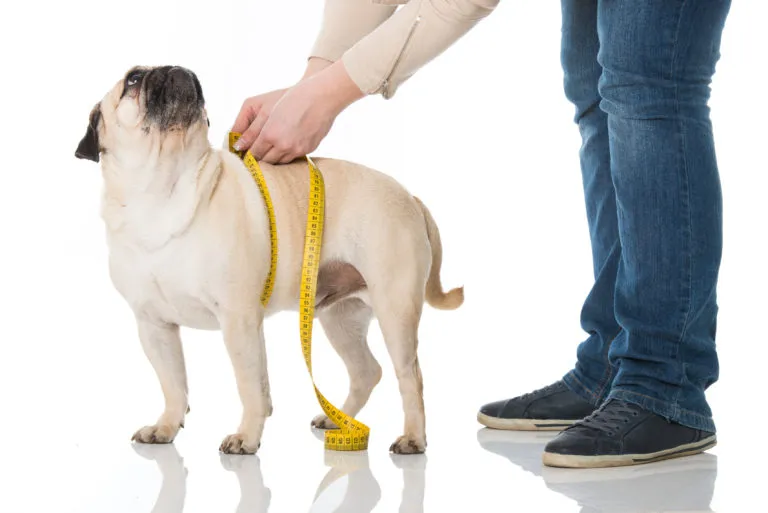Who could resist those begging eyes? A few treats or leftover food from the table won't be too bad, right? Although many dog owners know that obesity harms their pets, they often only take action much too late. Perhaps because a few rolls of fat don't bother them or because they simply can't recognise the onset of obesity.
However, obesity is a health problem affecting dogs that should be taken seriously. It can be countered with a sensible diet plan and a suitable exercise schedule. But what measures help to counteract excess fat and how does a change in food contribute to weight loss?
What are the consequences of obesity for dogs?
Overweight dogs suffer more regularly from certain diseases than those with a normal weight. Obese dogs often have an above-average tendency to develop joint diseases, like arthrosis or osteoarthritis, diabetes, cardiovascular and respiratory diseases. As well, they face an increased risk when under anaesthetic for surgical procedures. Obesity reduces dogs’ enjoyment of life, because they are less agile and often develop aches and pains, and their life expectancy too. On average, obese dogs die a whole two years earlier than their slimmer counterparts.
What are the causes of obesity?
Before you take action, however, you should first of all be aware of what causes your dog’s obesity, because the best diet means nothing if the causes of obesity haven’t been tackled. Since there are many diverse factors that can lead to the onset of obesity, you should first take your dog to be examined by a vet. Your vet will be able to tell you if your dog’s obesity is simply down to an incorrect diet or whether there is another ailment behind it that requires special treatment.
Possible triggers of obesity are the breed’s genetic disposition, old age having a negative impact on the metabolism, castration or even hormonal ailments like hypothyroidism or renal hyper-function. Diseases that can lead to dogs getting less exercise, such as hip dysplasia, arthrosis, circulatory or respiratory diseases, can also cause weight gain.
Along with these organic factors, there is a range of external influences that encourage obesity. In this case, the dog owner is mostly responsible. Not looking after the dog properly, a lack of time and exercise, poor nutritional habits or a misplaced love leading to the dog also being “rewarded” with high-calorie treats can trigger obesity.
How can you recognise obesity?
Unfortunately there is no Body Mass Index for dogs, which is an easy way of calculating their ideal weight. The sheer variety of dog breeds with often greatly differing physiques doesn’t allow for a uniform method of calculating obesity. However, an approximate rule of thumb does help to recognise obesity at an early stage:
This involves touching your dog’s ribs. If you can easily feel the ribs under the abdominal wall when you gently touch it, your dog is generally of a normal weight. If you can’t feel the ribs even if you put pressure on the side of the chest, your dog needs to lose weight. Incidentally, if you can see the ribs with your naked eye, your dog is underweight. In this case too, you should ask your vet for advice.
Losing weight healthily – but how?
The first step in the battle to lose weight is recognising that your dog is overweight. A consultation with your vet is the next step, in which you should clarify the causes of obesity and also come up with a weight loss plan for your dog. Although the current market offers many light food products for dogs that are easy to buy, they aren’t necessarily suitable for losing weight.
Light dog foods
Since the term “light” is not legally protected, this means that the assessment of what is “light” and what isn’t is solely down to the manufacturer. What one manufacturer calls “light” may contain just as many calories as a normal food from a different manufacturer. In order to determine whether the dog food is suitable, taking a look at the packaging label is the only option. Hence, expert knowledge of what proportion of what ingredients do your dog good and can help it lose weight is essential.
Diet food
In many cases, it’s safer to choose a special diet food prescribed by your vet. In contrast to the term “light”, “diet food” is legally protected, meaning there is an EU guideline specifying which indications are reliable and which data has to feature on the packaging, such as feeding quantity and calorie content. The latter is much lower with diet food than with an average dog food. Despite the reduced energy content, you can be sure that diet food still contains important vitamins, minerals and trace elements and provides your dog with all the nutrients that it needs.
Anti-inflammatory Omega-3 fatty acids in diet food ensure that the blood sugar level remains stable. In addition, high-quality reduction diets are defined by a high protein content. This makes food for carnivorous dogs tasty and also encourages targeted reduction of fat at the same time as maintaining muscle. The right quantity of fibre also gives dogs a feeling of satiety, making them satisfied and not constantly begging for more food. Hence, maintaining a diet becomes slightly easier.
No FdH diet
In most cases, diet foods are better suited to successful weight loss than conventional light versions produced by food manufacturers. FdH diets, in casual terms “eat half as much” (“Friss die Hälfte”), are also to be advised against. Reducing portion sizes doesn’t just lower calories, but unfortunately too important vitamins and minerals, which in turn can lead to deficiency symptoms. In addition, your dog won’t suddenly get less hungry, meaning that it will start to beg and its imploring eyes will make it rather difficult for you to stay strong and avoid treats.
Exercise – the second factor to tackle obesity
In order to lose weight, you should definitely avoid standard dog foods and gradually get your dog accustomed to a special diet food. However, changing the food alone can’t bring the success you desire. You also have to give your dog sufficient exercise. Plenty of training, sport and games don’t just help to suppress feelings of hunger, but also trigger increased energy consumption. Excess fat is broken down and your bond with your dog is strengthened by doing activity together.
Hence, your dog losing weight has a positive effect on both its health and also its joy of life and your relationship with one another. On this note, good luck with the weight loss journey!

